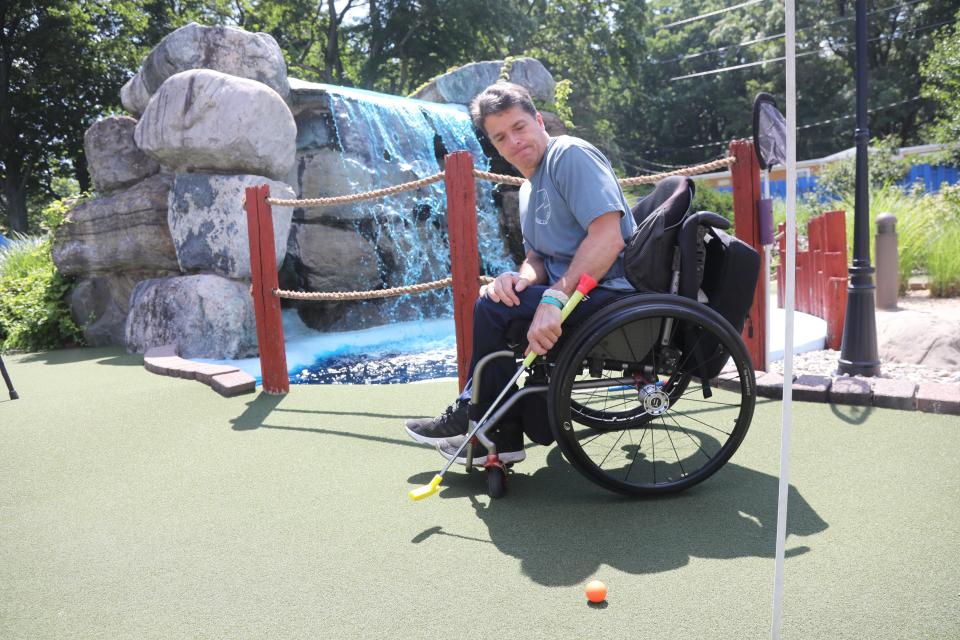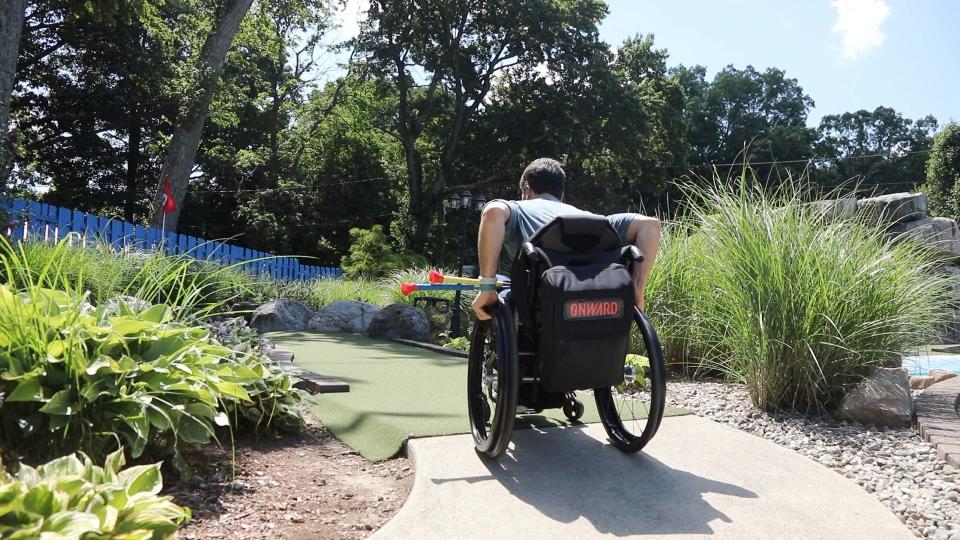NJ mini golf courses are full of obstacles for people with disabilities. What we found
WAYNE — As I stood on the green-carpeted hill, by a waterfall an unnatural hue I'll call Slushy Blue, I tried to balance on my two walking canes while wielding a mini golf putter. The words of Bill Botten came back to me.
“Everything should be accessible,” Botten, a coordinator with the U.S. Access Board, the agency responsible for writing Americans with Disabilities Act guidelines, had said.
Those words were the reason I was here with wheelchair-user Scott Chesney, 52, of Verona, as we tried our best to get through 18 holes of what was advertised as a 36-hole miniature golf course at the Willowbrook Golf Centeralong Route 46 in Wayne.
Mini golf is a summer staple, but it's largely inaccessible to players like us despite ADA requirements. In June, the Access Board hosted a webinar for course designers and ownersand blasted out emails to remind the public that even mini-golf, with its windmills, water traps and impossible angles, should be open to all.
I write about disability for the USA TODAY Network New Jersey. Scott is a motivational speaker dedicated to raising the profile of the differently abled. We decided to see for ourselves whether mini golf could be made accessible.
What we found at Willowbrook, which offers two 18-hole courses arranged around a faux stone mountain, left a lot to be desired.
But there's at least one other North Jersey course that shows it can be done better. More on that later.
'A lot of places are not in compliance'
First, a review of what the law requires.
Rules drawn up by the Access Board aim to make the game “fun and fair” for everyone, Botten said, by considering people with limited mobility when courses are designed.
A ball is supposed to be reachable from anywhere it lands using a 36-inch-long putter. There should be a path wide enough for wheelchairs to pass through each hole.
Businesses must have an adjustable putter available, allowing golfers to position the club head parallel to the ground even while sitting in a wheelchair. The board also sets limits on the pitch of a green, so holes aren't too steep.
It also gives operators a lot of leeway: A course is considered accessible if just half of its holes are in compliance, though those holes must be consecutive. And as in other industries, mini golf courses may be excused if they argue that accommodations would be too "onerous" to add.

There are an estimated 5,000 miniature golf courses across the country, according to Smithsonian magazine. Botten has looked at many of them and found that “a lot of places are not in compliance” with the ADA, especially in shore towns where the courses are raised high on small plots of land.
“They build a hill to put the course on,” he said. “They want you to be able to see the excitement from the street."
Related:Where to find adaptive golf courses in New Jersey that are accessible to all
The Willowbrook course — which declined repeated requests to comment for this story — did not have an adjustable putter available for Scott, the first sign that we would be running into more obstacles than expected.
Scott was paralyzed by a stroke as a teenager. I was born with cerebral palsy and use canes to get around. Scottis more of a natural athlete than I, and he clobbered me on almost every hole in spite of the compromising positions he had to put himself in time and again to play the game.
At one hole, he was somehow able to balance his chair on a banking curve and take a shot. With one wheel perched at the edge of a narrow path while stopped on a hill, he was able to putt accurately.
Still, he was discouraged.
“The whole thing with miniature golf — the nooks, the crannies, the dimensions, the hills, the slants, the curves — that all is what mini golf is about, and that doesn’t bode well for a person with a mobility disability,” he said.
There's no denying that the bridges, waterfalls, twisting streams and volcanoes add to the excitement. I’ve woven around, through, under and over many such obstacles through the years, and I have to admit — even as someone with a disability — it never occurred to me that miniature golf should be accessible.
Maximum slopes, minimum landings
Scott and I were playing 18 of 36 holes because these were the holes the employeeat the front desk jotted down as being our best bets when he saw the guy with canes and the guy in the wheelchair come in the door. But they weren't passing muster.
As Scott navigated the obstacles, he considered them from different perspectives. Referring to himself as a “para,” shorthand for paraplegic, or someone who has lost mobility in their lower limbs, he wondered if a “quad,” someone with limited use of all four limbs, would be able to keep their body upright while balancing a wheelchair on an incline. Could they do it long enough to take a shot without tipping over?
“Definitely not,” he said.
Under the ADA guidelines, accessible routes may include a maximum slope of 25% for a maximum 4-inch rise, while slopes on landings must be no more than 5%. Landings must be 48 inches long, and "where ramps change direction, the landing size must be a minimum of 48 inches by 60 inches."
Scott travels the world sharing his story in an effort to give people a more realistic picture of life with a disability. I aim to accomplish a similar feat for readers and policymakers, knowing that a lack of understanding is why the ADA allows golf courses to get away with half of their holes being inaccessible.
Ever take your family out for an afternoon of fun in the sun and then have to abandon the plans halfway through?
We played far less of the Willowbrook course before putting our putters away. Surrounding each hole were brick pavers Scott had to pop wheelies to get over. Curbs are meant to keep balls in play, but they should not exceed an inch high and there should have been 32-inch openings for wheelchair access, the standards say.
The curbs, slopes, and narrow and twisting paths and the lack of adaptive clubs took what most people think of as an easy day in the sun and turned it into more of an endurance test for us.
"There has to be a way to make it more accessible," Scott said after we left the course.
In a world chock-full of obstacles that are invisible to most, such as flights of stairs, there are constant reminders that the world wasn’t designed for people with disabilities. But that conclusion shouldn’t lead to acceptance, Botten said.
“Whether it is a dog park, frisbee golf, a horseshoe ring, I don’t care what it is, it needs to be accessible,” said Botten, who is a senior accessibility specialist.
Accessible course means more business
Castle Cove Mini Golf & Arcade sits along Route 15 south in Lake Hopatcong and advertises accessibility on its website.
Behind castle walls that rise above the highway, we found holes with openings wide enough for wheelchair access. The facility offers suction cups that can be placed at the end of any putter, making it easier to grab balls out of holes.
The slopes were reasonable for me. Scott, however, had some concerns. He found a number of holes with slopes steep enough to make him worry about tumbling forward out of his chair. He navigated them by leaning back far enough in his chair to bring his front wheels off the ground. He used his upper body strength to maintain a slow wheelie down each slope.

The course didn't have extravagant obstacles like windmills or tunnels. But the holes were inventive enough to keep the game interesting. Hint: Don’t fret if your ball finds its way into a water hazard at Castle Cove. All is not lost!
Manager Veronica Rossi said the owners had accessibility in mind when laying out the course, thinking it would be important for a family-friendly attraction. She added that meeting ADA requirements isn't a financial burden when they are considered at the start.
“When you are designing and following the right measurements, it shouldn’t be any more expensive,” she said.
In fact, making an accessible course has brought more business to Castle Cove, Rossi said. Local churches, schools, group homes and camps for people with disabilities all book time on the course because of its advertised accessibility.
In my case, that forethought paid off. There were a couple of steep inclines, but I never felt shut out. As the game went on, I got more comfortable, learning to balance my two canes in one hand while I gripped the putter in the other.
On this course, at least, I felt welcome.
Ironically, the exit marked with a wheelchair sign offered Scott the biggest hurdles. The sign pointed to a rickety bridge with loose moving boards that were scary to traverse. Rossi said the owners were planning to stabilize it. Past that was a slope too long and steep to manage. Scott had to ask for help.
"It's not accessible if you can't do it on your own," he said.
Gene Myers covers disability and mental health for NorthJersey.com and the USA TODAY Network. For unlimited access to the most important news from your local community, please subscribe or activate your digital account today.
Email: myers@northjersey.com
Twitter: @myersgene
This article originally appeared on NorthJersey.com: Accessible mini golf courses lacking for people in NJ

